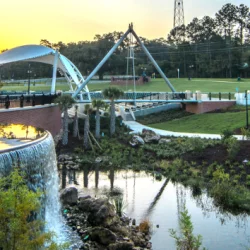HVAC Contractor Tips For Choosing the Best Place To Install Your AC
Intelligent architecture isn’t just focused on design; it’s also about ideal functionality. Unfortunately, many people may not consider the impact an HVAC system has on their building. However, this component shouldn’t be overlooked when designing a home.
Having healthy and fresh air in your home has never been so important. And while there are some alternatives to air conditioning, 87% of all US homes have AC of some sort. Unfortunately, many homeowners incorrectly assume that the most inconspicuous location is always the best place to put their AC unit, without considering the potential drawbacks.
But in this instance, it’s best to consult the experts. Polestar Plumbing, Heating & Air Conditioning, an air conditioning service company in Kansas City, recommends strategically placing your system. This statement is especially vital for residential properties with large outdoor AC units. The fact is that your air conditioner’s location matters in terms of its long-term performance and its longevity.
When choosing where to put your AC unit, what factors should you account for in the building’s architectural design? We’ll help you decide, and we’ll explain why your AC unit’s location is so important.
The different types of AC units
There are many types of AC systems. For example, split air conditioners, central air conditioners, and ductless mini-split air conditioners have internal condensers and external units that sit outside the home. These are the most effective AC units to cool large spaces efficiently. However, air conditioners that do not have an external condenser, such as portable and window AC units, are less efficient and may lead to higher electricity bills.
Does air conditioner placement matter?
We know that the aesthetics of your home are important, which is why so many homeowners put their external AC units in the least visible position. However, we also know that not paying more than you need for your energy is essential, too. That’s why it’s worth giving your air conditioner’s location a little more thought.
Home architecture is extremely purposeful. Each wall is placed with precision, and each floorplan is designed with homeowners in mind. And because every structure is unique, there isn’t a one-size-fits-all approach to finding the perfect HVAC system location. In addition, the different types of heating and cooling units complicate matters even further.
Split air conditioners, central air conditioners, and ductless mini-split air conditioners pull in air from the outside to cool your home. The hotter that air is, then the harder your unit has to work. That’s why, on scorching days, it takes longer for your air conditioning system to lower the temperature of your home.
Hot days in the summer months are unavoidable, but by placing your AC unit in a more strategic position, it is possible to reduce how hard it has to work to cool that air. That leads to lower energy bills and also potentially fewer repairs.
Selecting a good location for your air conditioner
Very simply, the best place to install an air conditioner is in an area that doesn’t see much direct sunlight and is on the cooler side of your home. Typically, that’s the side that faces either north or east. Aside from that, there are also a few other factors that our HVAC installation technicians consider, including:
- Air circulation
Not sure where to put your AC unit? One of the first factors to consider is air circulation. An AC unit needs to have a good level of air circulation around it to work efficiently. We always look for at least a two-foot gap between the unit and any nearby obstructions such as walls, shrubs, and fences. That also makes life easier for your AC servicing and maintenance team.
- Flooding
A small amount of water won’t do any harm at all to your condenser unit, but standing water can lead to corrosion, clog the condenser fins, and damage the electrical parts of the condenser. That’s why your AC unit should never be installed in an area where standing water collects.
- Vibrations
The condenser unit’s motor vibrates whenever it runs, leading to excessive noise, displacement, and even damage to the refrigerant line. To achieve a high-quality HVAC installation, you should place the air conditioner on a hard surface. If the natural ground is not firm enough, it can easily be placed on a concrete slab.
Where to put your outdoor AC unit - high or low?
Due to their individual architectural design, each building will need to be analyzed by an HVAC expert before any installation work begins. However, there are general guidelines that may give you a better idea of which type of cooling unit you need and where it could be placed.
For example, when installing a split AC system, it’s advisable to keep the outdoor unit higher than the indoor unit whenever possible. Your air conditioning system will still work if the outdoor unit is lower than the indoor unit, but some of the compressor’s power will be used to pump the refrigerant against the force of gravity. That will reduce the efficiency of your AC unit and increase your bills.
The maximum height difference between an external and internal AC unit differs depending on the make and model of the system. A reputable HVAC contractor will always be able to advise you on the best installation height and location for your home.
More to Read:
Previous Posts:




